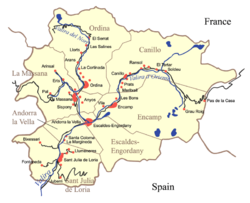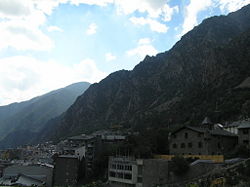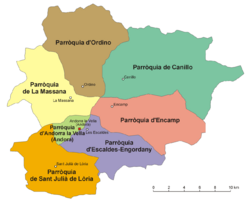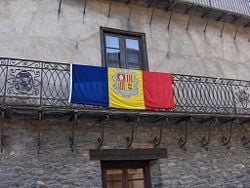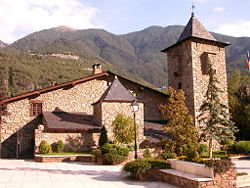Andorra
| Principat d'Andorra Principality of Andorra |
||||||
|---|---|---|---|---|---|---|
|
||||||
| Motto: "Virtus Unita Fortior" (Latin) "Virtue United is Stronger" |
||||||
| Anthem: El Gran Carlemany, Mon Pare (Catalan) The Great Charlemagne, my Father |
||||||
| Capital (and largest city) | Andorra la Vella 42°30′N 1°31′E | |||||
| Official languages | Catalan[1]3 | |||||
| Ethnic groups | 36.6% Andorran, 33.0% Spanish, 16.3% Portuguese, 6.3% French, 7.8% others.[2] | |||||
| Demonym | Andorran | |||||
| Government | Parliamentary democracy and Co-principality | |||||
| - | Co-Princes | Joan Enric Vives Sicília Nicolas Sarkozy |
||||
| - | Representatives | Nemesi Marqués Oste Christian Frémont |
||||
| - | Prime Minister | Antoni Martí | ||||
| Independence | ||||||
| - | Paréage | from the Crown of Aragon 1278 |
||||
| Area | ||||||
| - | Total | 467.63 km² (191st) 180.55 sq mi |
||||
| - | Water (%) | 0.26 (121.4 ha)[3][4] | ||||
| Population | ||||||
| - | 31 December 2009 estimate | 84,082[5] (194th) | ||||
| - | 2006 census | 69,150 | ||||
| - | Density | 179.8/km² (69th) 465.7/sq mi |
||||
| GDP (PPP) | 2008 estimate | |||||
| - | Total | $4.22 billion (155th) | ||||
| - | Per capita | $44,900 (9th) | ||||
| GDP (nominal) | 2008 estimate | |||||
| - | Total | $2.893 billion[6] (155th) | ||||
| - | Per capita | $34,240[6] (28th) | ||||
| Gini (2003) | 27.21[7] | |||||
| Currency | Euro (€)1 (EUR) |
|||||
| Time zone | CET (UTC+1) | |||||
| - | Summer (DST) | CEST (UTC+2) | ||||
| Internet TLD | .ad2 | |||||
| Calling code | [[++376]] | |||||
| 1 | Before 1999, the French franc and Spanish peseta; the coins and notes of both currencies, however, remained legal tender until 2002. Small amounts of Andorran diners (divided into 100 centim) were minted after 1982. | |||||
| 2 | Also .cat, shared with Catalan-speaking territories. | |||||
| 3 | Spanish, French, and Portuguese are also widely spoken and understood. (See Languages of Andorra) | |||||
Andorra, officially the Principality of Andorra, is one of the smallest states in Europe. At 180 square miles (468 sq. km.), it is about half the size of New York City. A small independent coprincipality of Spain and France, it is located on the south slopes of the Pyrenees Mountains. Once isolated, it is a prosperous country mainly because of tourism and its status as a tax haven. It had the highest life expectancy in the world in 2007, at 83.52 years.
Andorra was created by Charlemagne to serve as a buffer state in order to keep the Muslim Moors from advancing into Christian France. A strong affinity with Spain's northern region of Catalonia is longstanding; its institutions are based on Catalonian law, its language is Catalan, as is a large portion of its Spanish immigrants and their descendants.
The Madriu-Perafita-Claror Valley, a haven for rare or endangered wildlife and considered the "spiritual heart" of Andorra, was designated a UNESCO World Heritage Site in 2004.
Geography
The name "Andorra" is of unknown origin but (according to Joan Coromines) clearly pre-Roman. Many of the local toponyms are of Iberian-Basque origin. Its area is 181 square miles (468 square km) or 2.5 times the size of Washington, DC.
Befitting its location in the eastern Pyrenees mountain range, Andorra consists predominantly of rugged mountains of an average height of 6548 feet (1996 meters) with the highest being the Coma Pedrosa at 9665 feet (2946 meters). These are dissected by three narrow valleys in a Y shape that combine into one as the main stream, the Valira river, leaves the country for Spain, at Andorra's lowest point of 2854 feet or 870 meters.
The Madriu-Perafita-Claror Valley is a glacial valley in the southeast of Andorra. It covers an area of 42.47 km², approximately 9 percent of the total area of the state, and is part of the second largest watershed basin in Andorra. The isolated valley is recognized as a haven for rare or endangered wildlife, and the undeveloped valley is considered to be the "spiritual heart" of Andorra. It became Andorra's first, and to date its only, UNESCO World Heritage Site in 2004, with a small extension in 2006.
Andorra's climate is similar to its neighbors' temperate climates, but its higher altitude means there is on average more snow in winter and it is slightly cooler in summer. Temperatures at Andorra la Vella range from an average of around 30°F (-1°C) in January and 68°F (20°C) in July. Rainfall is 32 inches (808mm) a year.
The plant and animal life is similar to that found in neighboring France and Spain. Chestnut and walnut trees grow around Sant Julía de Lòria, the lowest village. Evergreen oaks are common, while pines, firs, and various forms of subalpine and alpine plant life grow in higher regions. Bears, wolves, foxes, martens, Pyrenean chamois, rabbits, hares, eagles, vultures, wild ducks, and geese live in isolated areas.
Natural resources include hydropower, mineral water, timber, iron ore, and lead.
Natural hazards include avalanches. Environmental issues include deforestation, overgrazing of mountain meadows which contributes to soil erosion, air pollution, and issues relating to wastewater treatment and solid waste disposal.
The capital Andorra la Vella, with a population of 22,035 in 2004, is located high in the east Pyrenees between France and Spain. It is also the name of the parish that surrounds it. The town of Santa Coloma is located in the province.
History
An archaeological site of Balma Margineda dates back 8,000 years, although full occupation was not achieved until 2000 B.C.E. Andorra had a stable population during the Roman era. Iberian populations mixed with peoples arriving from central Europe until Arab occupation in the eighth century.
At the beginning of the ninth century, the area was repopulated. Andorra was part of a buffer states created by Charlemagne to keep the Islamic Moors from advancing into Christian France. Tradition holds that Charlemagne (747-814) granted a charter to the Andorran people in return for their fighting the Moors. In the 800s, Charlemagne's grandson, Charles the Bald (823-877), named the Count of Urgell as overlord of Andorra. A descendant of the count later gave the lands to the Diocese of Urgell, headed by Bishop of Urgell.
The first document that refers to Andorra is the "Act of Consecration" of the Cathedral of Urgel in 839. In the eighth and ninth centuries, Andorra belonged to the County of Barcelona, which ceded sovereignty over the valleys of Andorra in 988 to the Episcopal see of Urgel (Spain).
In the eleventh century, fearing military action by neighboring lords, the bishop placed himself under the protection of the Lord of Caboet, a Catalan nobleman. Later, the Count of Foix became heir to the Lord of Caboet through marriage, and a dispute arose between the French Count and the Catalan bishop over Andorra.
The conflict was resolved in 1278 by the signing of a paréage, which provided that Andorra's sovereignty be shared between the count of Foix (whose title would ultimately transfer to the French head of state) and the bishop of La Seu d'Urgell, in Catalonia, Spain. The pareage, a feudal institution recognizing the principle of equality of rights shared by two rulers, gave the small state its territory and political form. In return, Andorra pays an annual tribute or questia to the co-rulers consisting of four hams, 40 loaves of bread, and some wine. As of the year 2006, Andorra's borders have remained unchanged since 1278.
Andorra was briefly annexed to Aragon twice, in 1396 and 1512.
Over the years the title passed to the kings of Navarre. After Henry of Navarre became King Henry IV of France, he issued an edict (1607) that established the head of the French state and the Bishop of Urgell as co-princes of Andorra.
In the period 1812–1813, the First French Empire annexed Catalonia and divided it in four départements. Andorra was also annexed and made part of the district of Puigcerdà (département of Sègre).
Andorra declared war on Imperial Germany during World War I but did not actually take part in the fighting. It remained in an official state of belligerency until 1957.
In 1933 France occupied Andorra as a result of social unrest before elections. On July 12, 1934, an adventurer named Boris Skossyreff issued a proclamation in Urgell, declaring himself Boris I, sovereign prince of Andorra, simultaneously declaring war on the bishop of Urgell. He was arrested by Spanish authorities on July 20 and ultimately expelled from Spain. From 1936 to 1940, a French detachment was garrisoned in Andorra to prevent influences of the Spanish Civil War and Franco's Spain. Francoist troops reached the Andorran border in the later stages of the war.
During World War II, Andorra remained neutral and was an important smuggling route between Vichy France and Spain.
In 1958 Andorra declared peace with Germany, having been forgotten on the Treaty of Versailles that ended the First World War and, the conflict being extended by the lack of a peace treaty, remaining legally at war.
Given its relative isolation, Andorra has existed outside the mainstream of European history, with few ties to countries other than France and Spain. In recent times, however, its thriving tourist industry along with developments in transportation and communications have removed the country from its isolation and its political system was thoroughly modernized in 1993, the year in which it became a member of the United Nations.
Government and politics
Before 1993, Andorra's political system had no clear division of powers into executive, legislative, and judicial branches. A constitution was ratified and approved in 1993 which establishes Andorra as a sovereign parliamentary democracy that retains as its heads of state a co-principality (or duumvirate), but the head of government retains executive power. The two co-princes—the president of France and Bishop of Seo de Urgel, Spain,—serve coequally with limited powers that do not include a veto over government acts. They are represented locally by co-princes' representatives.
Andorra's main legislative body is the 28-member unicameral General Council of the Valleys. The sindic (president), the subsindic and the members of the Council are elected by direct popular vote, 14 from a single national constituency and 14 to represent each of the seven parishes, to serve four-year terms. The council meets throughout the year on certain dates set by tradition or as required. Suffrage is universal to those aged 18 years of age and over.
The judicial system is independent. Courts apply the customary laws of Andorra, supplemented with Roman law and customary Catalan law. Civil cases are first heard by the battles court—a group of four judges, two chosen by each co-prince. Appeals are heard in the Court of Appeals. The highest body is the five-member Superior Court of Justice. The legal system is based on French and Spanish civil codes. There is no judicial review of legislative acts. Andorra has not accepted compulsory International Court of Justice jurisdiction.
Andorra's young democracy is in the process of redefining its political party system. Three out of the five parties that dominated the political scene in past years have dissolved. Parties in 2007 included the Andorran Democratic Center Party or CDA (formerly Democratic Party or PD), Century 21, the Liberal Party of Andorra or PLA, and the Social Democratic Party.
Andorra consists of seven communities known as parishes. The parishes are: Andorra la Vella, Canillo, Encamp, Escaldes-Engordany, La Massana, Ordino, and Sant Julià de Lòria. Some parishes have a further territorial subdivision. Ordino, La Massana and Sant Julià de Lòria are subdivided into quarters, while Canillo is subdivided into neighborhoods. Those mostly coincide with villages, which are found in all parishes.
Andorra had no military force in 2007. Responsibility for defending Andorra rests with Spain and France.
Economy
Tourism, the mainstay of Andorra's tiny, well-to-do economy, accounts for roughly 80 percent of GDP. An estimated nine million tourists visit annually, attracted by Andorra's duty-free status and by its summer and winter resorts. There is a fairly active trade in consumer goods, including imported manufactured items, which, because they are duty-free, are less expensive in Andorra than in neighboring countries. As a result, smuggling is commonplace. Andorra's comparative advantage has recently eroded as the economies of adjoining France and Spain have been opened up, providing broader availability of goods and lower tariffs.
The banking sector, with its tax haven status, also contributes substantially to the economy. Agricultural production is limited—only two percent of the land is arable—and most food has to be imported. The principal livestock activity is domestic sheep raising. Manufacturing output consists mainly of cigarettes, cigars, and furniture.
Andorra is a member of the EU Customs Union and is treated as an European Union member for trade in manufactured goods (no tariffs) and as a non-EU member for agricultural products. Andorra lacks a currency of its own and uses that of its two surrounding nations. Prior to 1999 these were the French franc and the Spanish peseta, which have since been replaced by a single currency, the euro.
Exports totalled $148.7-million in 2005. Export commodities included tobacco products, and furniture. Export partners included Spain 59.5 percent, and France 17.0 percent (2006). Imports totalled $1.879-billion in 2005. Import commodities included consumer goods, food, and electricity. Import partners included Spain 53.2 percent, and France 21.1 percent. Per capita GDP was $38,800 in 2007, a rank of seven out of 194 countries.
Demographics
With a population of 71,822 in 2007, Andorrans are a minority in their own country; Spaniards, Portuguese, Frenchmen, and Britons resident in Andorra make up 67.7 percent of the population. Life expectancy at birth for the total population in 2006 was 83.51 years, the highest in the world.
Even though Andorra lacks a formal religion, the predominant religion is Catholicism, mainly because of the role of the bishop of Urgel as co-prince and, at the same time, head of the Andorran Church. Jehovah's Witnesses make up the sole alternative religious group. Among famous feasts are the one honoring Sant Jordi, when books and roses are given as presents; the People's feast, celebrating Saint John and the summer solstice, and the feast of Saint Stephen (Sant Esteve), patron saint of Andorra la Vella. Andorrans tend to celebrate their feasts gladly and loudly.
The national language is Catalan, a romance language. It is used in government, taught in schools, appears on road signs, and dominates the communications media. Other languages stemming from the immigration such as Spanish and French are also commonly spoken. Portuguese is also noticeable.
Andorran society, with its strong rural origins, maintained segregated gender roles until the late twentieth century, with men taking all public roles. Rapid urbanization and commercialization have made women visible in the work force, although their presence in political spheres remains inferior to that of men.
Marriages between Andorrans and Spaniards or French are normal, and couples tend to marry within their class. The family remains the basic social unit. Most enterprises are organized through the family, assigning roles according to the ability and education level of each member. While the inheritance system formerly passed nearly everything to one son, this pattern is limited to the transmission of the family home. In rural areas, only the inheriting son can marry and reside with his wife and children on the family land. In March 2005, Andorra recognized the right of same-sex couples to join in civil unions.
Education law requires school attendance for children up to age 16. A system of French, Spanish and Andorran lay schools provide education up to the secondary level. Schools are built and maintained by Andorran authorities, but teachers are paid predominately by France or Spain. About 50 percent of Andorran children attend the French primary schools, and the rest attend Spanish or Andorran schools. In July 1997, the Andorran Government passed a law on universities and shortly afterward, the University of Andorra was established. Neither the geographically complex country nor the number of students makes it possible for the University of Andorra to develop a full academic program, and it serves principally as a center for virtual studies, connected to Spanish and French universities. The only two graduate schools in Andorra are the Nursing School and the School of Computer Science. Andorra claims a literacy rate of 100 percent.
Most of the original Andorran population belongs to the high or medium-high class as the first group to arrive there. The Spanish population tend to be salaried workers, including executives groups and entrepreneurs. Portuguese provide semi-skilled labor, especially in hostelry and construction. The French include bureaucrats and small-time entrepreneurs. The Andorran elite wear well-known international brands, and have access to luxury Rolls-Royce, Mercedes Benz, Audi, and BMW cars.
Culture
Andorran Culture is Catalan in essence, since the native-born population is Catalan. Andorra's long history has provided it with a rich folklore and an abundance of folk tales, with roots originating as far as Andalusia in the south and the Netherlands in the north.
The country has 30 small Romanesque churches, built between the ninth and the thirteenth centuries, and containing frescoes and wood carvings of great value, such as the Virgin of Canolic (which dates to the twelfth century). There are remains of old castles, medieval fortifications, and rural homesteads. Andorra has a "mountain style" of architecture which required 30 percent of any facade be constructed of stone masonry. Therefore, commercial buildings and urban public buildings combine stone with iron and large surfaces of glass. The seat of the Andorran parliament is a sixteenth-century palace-fortress built in stone.
The cuisine of Andorra is based on meat, garden vegetables, and some fish. The most common winter dish, in rural and urban zones, is escudella, a soup of veal, chicken, potatoes, and vegetables. The midday meal is eaten near the workplace in a restaurant.
Antoni Fiter i Rossell, from the parish of Ordino, wrote a history entitled Digest manual de las valls neutras de Andorra in 1748, describing the feudal historical and legal setting of Andorra. Two writers renowned in Catalonia and the region, Michèle Gazier and Ramon Villeró, both come from Andorra. Ricard Fiter, a renowned writer, also serves as the Principality's ombudsman.
Andorra has a Chamber Orchestra directed by the violinist Gérard Claret, and stages an international singing contest supported by Montserrat Caballé. In 2004, Andorra participated in the Eurovision Song Contest for the first time. This attracted media attention from Catalonia, since it was the first song to be sung in the Catalan language. The most important event in Andorran cultural life is the Escaldes-Engordany international jazz festival, where stars such as Miles Davis, Fats Domino and B.B. King have taken part.
Andorra is home to folk dances like the contrapàs and marratxa, which survive in Sant Julià de Lòria especially. Andorran folk music has similarities to all of its neighbors, but is especially Catalan in character, especially in the presence of dances like the sardana. Other Andorran folk dances include contrapàs in Andorra la Vella and Saint Anne's dance in Escaldes-Engordany.
Andorra was a new country in international football (soccer) in 2007, and the national team had existed for less than ten years. They recorded three victories against Belarus, Albania, and Republic of Macedonia, all of which were at home. They are known as one of the most penalized teams in Europe, having received more red and yellow cards in the WC 2006 Qualifiers than any other team. The most famous Andorran player is Albert Celades who has played for both FC Barcelona and Real Madrid. The mid-fielder even made it to the Spanish national team. Andorra has a number of ski resorts, and competes in tennis and in the Olympic Games.
Notes
- ↑ Constitution of Andorra (Article 2.1)
- ↑ Estadísticas de población de Andorra. Ministerio de Justicia e Interior de Andorra
- ↑ Girard P & Gomez P (2009), Lacs des Pyrénées: Andorre. (French)
- ↑ Andorra en xifres 2007: Situació geogràfica, Departament d'Estadística, Govern d'Andorra. Retrieved on 6 June 2010.
- ↑ Dades de població any 2009: 1- Població per parròquies al 31 de desembre del 2009, Departament d'Estadística, Govern d'Andorra. Retrieved on 6 June 2010.
- ↑ 6.0 6.1 Andorra 2008, Crèdit Andorrà.
- ↑ Estadistica.ad
ReferencesISBN links support NWE through referral fees
- Armengol Vila, Lídia. 1989. Approach to the history of Andorra. [Perpinya]: Institut d'Estudis Andorrans, Centre de Perpinyà. ISBN 9789991370156
- The World and its peoples: Spain, Portugal, Andorra, Gibraltar. 1963. New York: Greystone Press.
- Carrick, Noel. 1988. Andorra. New York, NY: Chelsea House Publishers. ISBN 9780791000991
External links
All links retrieved July 26, 2023.
- Andorra CIA World Factbook.
- Andorra Countries and Their Cultures.
- Andorra BBC Country Profiles.
- Andorra U.S. Department of State.
- History of Andorra: Primary Documents EuroDoc, EuroDocs Creator: Richard Hacken, European Studies Bibliographer.
Albania · Andorra · Armenia2 · Austria · Azerbaijan1 · Belarus · Belgium · Bosnia and Herzegovina · Bulgaria · Croatia · Cyprus2 · Czech Republic · Denmark3 · Estonia · Finland · France3 · Georgia1 · Germany · Greece · Hungary · Iceland · Ireland · Italy · Kazakhstan1 · Latvia · Liechtenstein · Lithuania · Luxembourg · Republic of Macedonia · Malta · Moldova · Monaco · Montenegro · Netherlands3 · Norway3 · Poland · Portugal · Romania · Russia1 · San Marino · Serbia · Slovakia · Slovenia · Spain3 · Sweden · Switzerland · Turkey1 · Ukraine · United Kingdom3 · Vatican City
1 Has majority of its territory in Asia. 2 Entirely in Asia but having socio-political connections with Europe. 3 Has dependencies or similar territories outside Europe.
Credits
New World Encyclopedia writers and editors rewrote and completed the Wikipedia article in accordance with New World Encyclopedia standards. This article abides by terms of the Creative Commons CC-by-sa 3.0 License (CC-by-sa), which may be used and disseminated with proper attribution. Credit is due under the terms of this license that can reference both the New World Encyclopedia contributors and the selfless volunteer contributors of the Wikimedia Foundation. To cite this article click here for a list of acceptable citing formats.The history of earlier contributions by wikipedians is accessible to researchers here:
- Andorra history
- History_of_Andorra history
- Andorra_la_Vella history
- Politics_of_Andorra history
- Demographics_of_Andorra history
- Culture_of_Andorra history
- Madriu-Perafita-Claror_Valley history
The history of this article since it was imported to New World Encyclopedia:
Note: Some restrictions may apply to use of individual images which are separately licensed.



